A monetary hoard of more than a hundred coins has just been unearthed on the site of Rome's most severe defeat, in Germania. A disaster that put an end to the policy of imperial expansion beyond the Rhine.
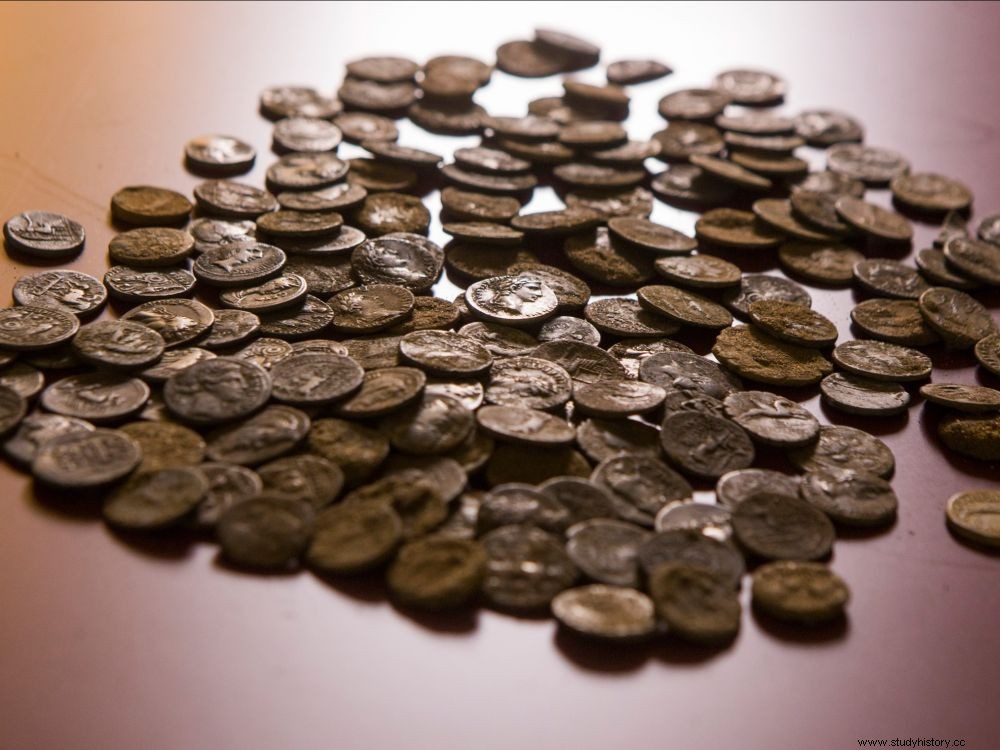
1st century CE Roman silver denarii discovered at the site of the Battle of Teutoburg, Germany.
It is the scene of one of the greatest Roman military disasters. There, in the hills of present-day Kalkriese in Westphalia (Germany), three Roman legions and their auxiliary troops (25,000 men) were totally massacred by Germanic tribes in the year 9 AD. in this soil of Teutoburg, which still conceals numerous remains, that German archaeologists from the Ludwig-Maximilians University of Munich (LMU) have just found a spectacular monetary treasure.
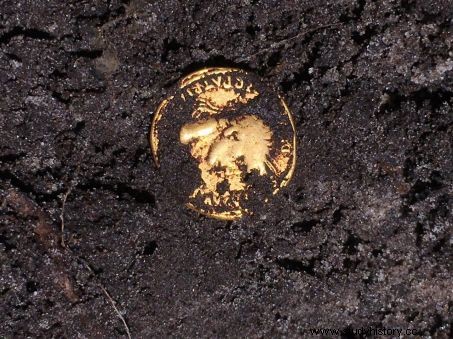
At the end of March 2017, one of the Roman coins unearthed in the Teutoburg Forest. © Varusschlacht gGmbh Museum and Park Kalkriese
"These are 102 silver denarii. This currently brings our finds to 220 coins from the reign of Emperor Augustus, not counting the gold aurei* exhumed last year", > says Marc Rappe, the archaeologist at the Kalkriese museum responsible for the excavations, contacted by Sciences et Avenir. How did this jackpot end up buried in the ground? "A Roman legionnaire caught in the trap will no doubt have wanted to quickly hide his fortune in the hope of finding it at the end of the battle...", he imagines.
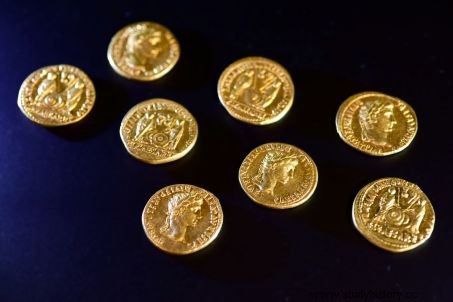
Aurei of gold from Teutoburg. © Varusschlacht gGmbh Museum and Park Kalkriese
This battle saw the legions of Publius Quinctilius Varus confront the men of a powerful coalition of Germanic peoples (Cheruscans, Bructera, etc.) led by Arminius. Its location has long been discussed. Indeed, since the 19 th century, Teutoburg is across the Rhine what Alésia is to France:a national myth long manipulated for political purposes, accompanied by strong tensions between localities, several of them having disputed the honor of having been the place of the ancient confrontation. Discussions finally closed in Germany since the end of the 1980s with the definitive location of the site at Kalkriese north of Osnabrück. More than 5500 remains of Roman objects and elements of military equipment have already been collected there:swords, daggers, javelin points, arrows, fragments of armour, helmets, - including an extraordinary mask bronze facial that can be admired in the city museum. Without forgetting everything that an army could carry in the field:cauldrons, axes, nails, hammers, amphoras, etc.
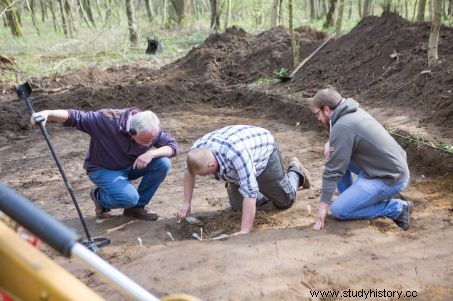
Archaeologists from the Ludwig-Maximilians University of Munich (LMU), accompanied by Marc Rappe from the Museum and Park Kalkriese, the head of the excavations, on the Teutoburg site (Germany), in April 2017. © Varusschlacht gGmbh Museum and Park Kalkriese
The latest book History of Roman Wars , by historian Yann Le Bohec (Taillandier, 2017), allows us to relive these three terrible days which saw the fall - and dishonor - by the loss of their eagles, the Roman legions XVII, XVIII and XIX. Numbers forever banished from the signs of Rome! Two men are at the heart of this tragedy against a backdrop of betrayal:the Roman governor Publius Quinctilius Varus, consular legate commanding the army of Germania, and Arminius, a Cheruscan leader. The latter, who had obtained Roman citizenship and the rank of knight, had in fact secretly joined the German rebels. Accompanying the imperial troops on these lands of Germania which he knew well, he had thus advised Varus to take a shortcut to reach his winter camps on the Rhine, crossing the Teutoburg forest. A "friendly" piece of advice that actually turned out to be "a real mousetrap writes Yann Le Bohec.
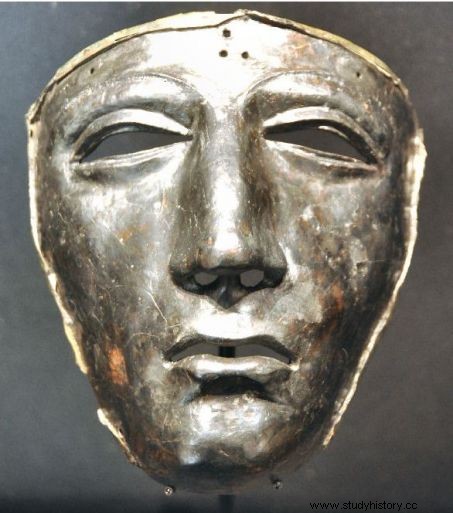
One of the most famous remnants of the Battle of Teutoburg:a Roman cavalry face mask. © Varusschlacht gGmbh Museum and Park Kalkriese
The soldiers of Rome indeed found themselves cornered in a thick forest. Having left as a scout, Arminius has in fact joined the Germans who then decide to go on the attack. When the first sounds of battle reach the ears of the Roman leader, Varus leads his army into the heart of the forest to help the vanguard... The trap closes:divided into cohorts accustomed to fighting in formation, the legions cannot to deploy themselves. In the middle of the trees, cuirasses and shields hinder the legionnaires. Besides, impossible to maneuver the war machines! On their side, the Germans, of which Arminius took the head, carry out ambushes. Caught between marshes and hills from which descend the German fighters in continuous waves, the Roman soldiers are torn to pieces. Later, the descriptions of the Roman historian Cassius Dion (155-235) will tell that those who were behind, unaware of the massacres in front, continued to throw themselves into the mouth of the wolf. The disaster is such that Varus will prefer to commit suicide rather than fall into the hands of his enemies. And his name will forever be associated with the clades Variana , the "Varus Disaster".
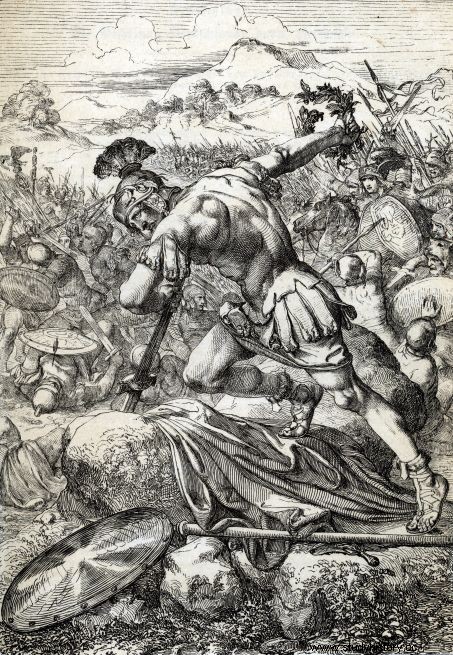
The suicide of Varus, in a 19th th illustration century. © Leemage/AFP
"Vae victis … Woe to the vanquished !
Experienced as a trauma, the disaster of Teutoburg brought a halt to the policy of Roman imperial expansion. Legend has it that Emperor Augustus woke up at night screaming, "Varus, give me back my legions!" ". On his death, the new Emperor Tiberius sent a new expeditionary force to Germany. In the year 15, returning to the scene of the battle, the Roman legionnaires whose beliefs wanted that the dead know a life in the tomb after death, will discover horrified that to humiliate them a little more, the German victors had left the bodies of 25,000 soldiers rot without burial... "Vae Victis... Woe to the vanquished ! Germanicus, a famous Roman general sent by Tiberius at the head of eight legions, buried what remained of the remains, many of which had been crucified and mutilated. As for Arminius, who had inflicted on Rome one of its worst defeats, he died assassinated in the year 21... betrayed in turn by a relative!
*Aureus: (plural aurei ) or gold denarius is a Roman currency. Its issue dates from the Roman Republic, and will be regular under the reign of Julius Caesar, then Augustus (late 1st century BC). It will then be minted throughout the Roman Empire. One gold aureus was equivalent to 25 silver denarii, or 100 sesterces.
